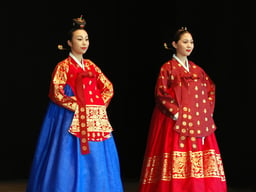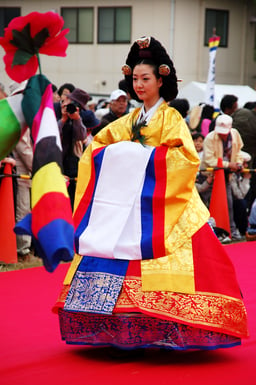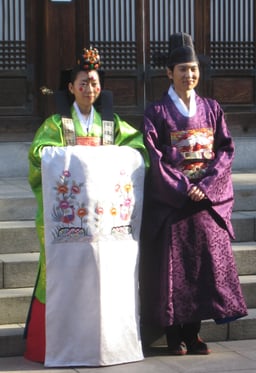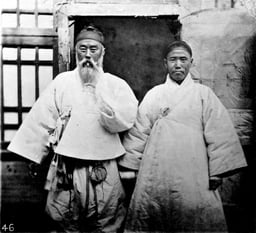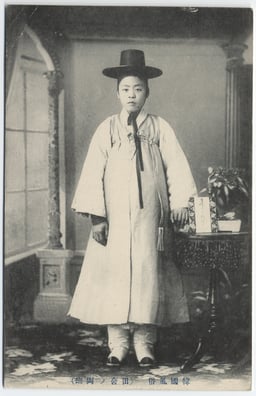Koreans
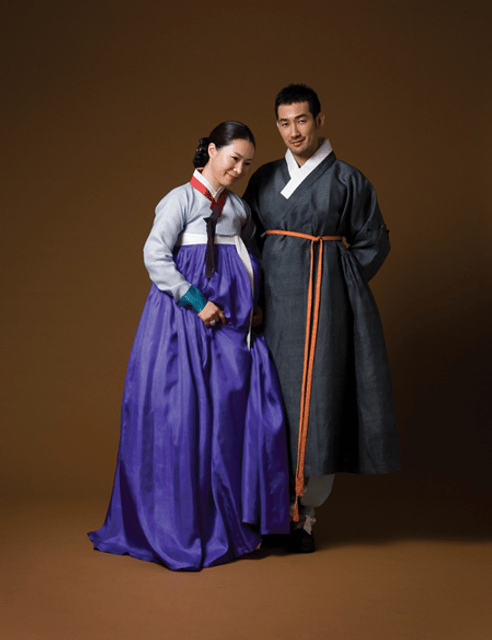
Koreans

| Total population | |
|---|---|
| [1] | |
| Regions with significant populations | |
| South Korea50,423,955 (2014 estimate)[2]North Korea25,300,000 (2014 estimate)[3]Diaspora as of 20177–7.43 million[4] | |
| China | 2,548,030[4] |
| United States | 2,492,252[4] |
| Japan | 818,626[4] |
| Canada | 240,942[4] |
| Uzbekistan | 181,077[4] |
| Australia | 180,004[4] |
| Russia | 169,638[4] |
| Vietnam | 124,458[4] |
| Kazakhstan | 109,133[4] |
| Philippines | 93,093[4] |
| Brazil | 51,531[4] |
| Germany | 40,170[4] |
| United Kingdom | 39,934[4] |
| New Zealand | 33,403[4] |
| Indonesia | 31,091[4] |
| Argentina | 23,194[4] |
| Thailand | 20,500[4] |
| Singapore | 20,346[4] |
| Kyrgyzstan | 19,035[4] |
| France | 16,251[4] |
| Malaysia | 13,122[4] |
| Ukraine | 13,070[4] |
| Mexico | 11,673[4] |
| United Arab Emirates | 10,852[4] |
| Cambodia | 10,089[4] |
| India | 10,390[4] |
| Taiwan | 6,293[4] |
| Tajikistan | 6,000[4] |
| Guatemala | 5,312[4] |
| Paraguay | 5,090[4] |
| Spain | 4,520[4] |
| Iraq | 1,540[4] |
| Languages | |
| Korean[5] | |
| Religion | |
| Majority:Folk religionorirreligiousMinorities:Christianity(predominantlyProtestantism, alsoCatholics),Korean Buddhism,Korean shamanism,Confucianism,Cheondoism[6][7] | |
Koreans (Korean: 한민족, 한국인, 한국사람; Hanja: 韓民族, 韓國人, 韓國사람; RR: Hanminjok, Hanguk-in, Hanguksaram in South Korean; alternatively Korean: 조선민족, 조선인, 조선사람; Hanja: 朝鮮民族, 朝鮮人, 朝鮮사람; RR: Joseonminjok, Joseonin, Joseonsaram in North Korean, lit. "Korean race"; see names of Korea) are an East Asian ethnic group native to Korea and southwestern Manchuria.[10][11][11][13][14]*The%20Making%20of%20International%20]]The%20Making%20of%20International%20]]
Koreans mainly live in the two Korean states: North Korea and South Korea (collectively and simply referred to as Korea). They are also an officially recognized ethnic minority in China, Japan, the Philippines, and Vietnam, plus in a number of Post-Soviet states, such as Russia, Kazakhstan and Uzbekistan. Over the course of the 20th century, significant Korean communities have formed in the Americas (especially in the United States and Canada) and Oceania.
As of 2017, there were an estimated 7.4 million ethnic Koreans residing outside Korea.[4]
| Total population | |
|---|---|
| [1] | |
| Regions with significant populations | |
| South Korea50,423,955 (2014 estimate)[2]North Korea25,300,000 (2014 estimate)[3]Diaspora as of 20177–7.43 million[4] | |
| China | 2,548,030[4] |
| United States | 2,492,252[4] |
| Japan | 818,626[4] |
| Canada | 240,942[4] |
| Uzbekistan | 181,077[4] |
| Australia | 180,004[4] |
| Russia | 169,638[4] |
| Vietnam | 124,458[4] |
| Kazakhstan | 109,133[4] |
| Philippines | 93,093[4] |
| Brazil | 51,531[4] |
| Germany | 40,170[4] |
| United Kingdom | 39,934[4] |
| New Zealand | 33,403[4] |
| Indonesia | 31,091[4] |
| Argentina | 23,194[4] |
| Thailand | 20,500[4] |
| Singapore | 20,346[4] |
| Kyrgyzstan | 19,035[4] |
| France | 16,251[4] |
| Malaysia | 13,122[4] |
| Ukraine | 13,070[4] |
| Mexico | 11,673[4] |
| United Arab Emirates | 10,852[4] |
| Cambodia | 10,089[4] |
| India | 10,390[4] |
| Taiwan | 6,293[4] |
| Tajikistan | 6,000[4] |
| Guatemala | 5,312[4] |
| Paraguay | 5,090[4] |
| Spain | 4,520[4] |
| Iraq | 1,540[4] |
| Languages | |
| Korean[5] | |
| Religion | |
| Majority:Folk religionorirreligiousMinorities:Christianity(predominantlyProtestantism, alsoCatholics),Korean Buddhism,Korean shamanism,Confucianism,Cheondoism[6][7] | |
Etymology
North Koreans refer to themselves as Joseon-in (Korean: 조선인; Hanja: 朝鮮人) or Joseon-saram (Korean: 조선 사람), both of which literally mean "Korean [Joseon] people". The term is derived from the Joseon dynasty, a Korean kingdom founded by Yi Seonggye that lasted for approximately five centuries from 1392 to 1910. Using similar words, Koreans in China refer to themselves as Chaoxianzu (Chinese: 朝鲜族) in Chinese or Joseonjok, Joseonsaram (Korean: 조선족, 조선사람) in Korean, which are cognates that literally mean "Joseon ethnic group".[14]The%20Making%20of%20International%20]] Koreans in Japan**,*** Jaeil Joseonin Joseonsaram Joseonin : 재일조선인, 조선사람, 조선인) in Korean
In the chorus of the South Korean national anthem, Koreans are referred to as Daehan-saram (Korean: 대한사람, lit. Great Korean people).
Origins
Linguistic and archaeological studies
Modern Koreans are suggested to be the descendants of the ancient people who settled in the northern Korean Peninsula, historically said to be Siberian.[18][19] Archaeological evidence suggests that proto-Koreans were migrants from Manchuria during the Bronze Age.[20] Genetic studies suggest an origin for the majority of ancestral-Koreans in southern China or Vietnam.[21] According to several linguists and historians the linguistic homeland of proto-Korean and of the early Koreans is located somewhere in Manchuria. Later, Koreanic-speakers already present in northern Korea started to expand further south, replacing and or assimilating Japonic-speakers and likely causing the Yayoi migration.[22][23] Whitman (2012) suggests that the proto-Koreans arrived in the southern part of the Korean Peninsula at around 300 BCe and coexisted with the descendants of the Japonic Mumun cultivators (or assimilated them).[24]
Linguistic evidence indicates speakers of proto-Korean languages were established in southeastern Manchuria and northern Korean peninsula by the Three Kingdoms of Korea period, and migrated from there to southern Korea during this period.[25]
The largest concentration of dolmens in the world is found on the Korean Peninsula. In fact, with an estimated 35,000-100,000 dolmen,[26] Korea accounts for nearly 70% of the world's total. Similar dolmens can be found in Manchuria, the Shandong Peninsula and the Kyushu island, yet it is unclear why this culture only flourished so extensively on the Korean Peninsula and its surroundings compared to the bigger remainder of Northeastern Asia.
Anthropometry
Stephen Pheasant (1986), who taught anatomy, biomechanics and ergonomics at the Royal Free Hospital and the University College, London, said that Far Eastern people have proportionately shorter lower limbs than Europeans and Black Africans. Pheasant said that the proportionately short lower limbs of Far Eastern people is a difference that is most characterized in Japanese people, less characterized in Korean and Chinese people, and the least characterized in Vietnamese and Thai people.[27][28]
Neville Moray (2005) said that, for Korean and Japanese pilots, sitting height is more than 54% of their stature, with about 46% of their stature from leg length. Moray said that, for Americans and most Europeans, sitting height is about 52% of their stature, with about 48% of their stature from leg length.[29]
Craniometry
In a craniometric study, Pietrusewsky (1994) found that the Japanese series, which was a series that spanned from the Yayoi period to modern times, formed a single branch with Korea.[30] Later, Pietrusewsky (1999) found, however, that Korean and Yayoi people were very highly separated in the East Asian cluster, indicating that the connection that Japanese have with Korea would not have derived from Yayoi people.[30]
Genetics
Studies of polymorphisms in the human Y-chromosome have so far produced evidence to suggest that the Korean people have a long history as a distinct, mostly endogamous ethnic group, with successive waves of people moving to the peninsula and two major Y-chromosome haplogroups.[32] The reference population for Koreans used in Geno 2.0 Next Generation is 94% Eastern Asia and 5% Southeast Asia & Oceania.[33] Another study finds 79% Southeast Asian and 21% Northeast Asian ancestry in modern Koreans.[34]
Genealogy
Korea Foundation Associate Professor of History, Eugene Y. Park said that many Koreans seem to have a genealogical memory blackout before the twentieth century.[35][36] According to him the vast majority Koreans do not know their actual genealogical history. Through "inventing tradition" in the seventeenth and eighteenth centuries, families devised a kind of master narrative story that purports to explain a surname-ancestral seat combination's history to the extent where it is next to impossible to look beyond these master narrative stories.[37] He gave an example of what "inventing tradition" was like from his own family's genealogy where a document from 1873 recorded three children in a particular family and a later 1920 document recorded an extra son in that same family.[38] Park said that these master narratives connect the same surname and ancestral seat to a single, common ancestor. This trend became universal in the nineteenth century, but genealogies which were published in the seventeenth century actually admit that they did not know how the different lines of the same surname or ancestral seat are related at all.[39] Only a small percentage of Koreans had surnames and ancestral seats to begin with, and that the rest of the Korean population had adopted these surname and ancestral seat identities within the last two to three hundred years.[40]
Culture

Children's Day in Cheong Wa Dae. Former South Korean President Park Geun-hye (center) hugs a boy at a meeting with children invited to Cheong Wa Dae to mark Children's Day on May 5
North Korea and South Korea share a common heritage, but the political division since 1945 has resulted in some divergence of their modern cultures.
Language
The language of the Korean people is the Korean language, which uses Hangul as its main writing system with a minor use of Hanja. There are more than 78 million speakers of the Korean language worldwide.[41]
Demographics

Traditional Korean royal wedding ceremony
Large-scale emigration from Korea began as early as the mid-1860s, mainly into the Russian Far East and Northeast China or what was historically known as Manchuria; these populations would later grow to more than two million Koreans in China and several hundred thousand Koryo-saram (ethnic Koreans in Central Asia and the former USSR).[42][43] During the Korea under Japanese rule of 1910–1945, Koreans were often recruited and or forced into labour service to work in mainland Japan, Karafuto Prefecture (Sakhalin), and Manchukuo; the ones who chose to remain in Japan at the end of the war became known as Zainichi Koreans, while the roughly 40 thousand who were trapped in Karafuto after the Soviet invasion are typically referred to as Sakhalin Koreans.[44][45]
South Korea
In June 2012, South Korea's population reached 50 million[46] and by the end of 2016, South Korea's population has surpassed 51 million people.[47] Since the 2000s, South Korea has been struggling with a low birthrate, leading some researchers to suggest that if current population trends hold, the country's population will shrink to approximately 38 million population towards the end of the 21st century.[48] In 2018, fertility in South Korea became again a topic of international debate after only 26,500 babies were born in October and an estimated of 325,000 babies in the year, causing the country to have the lowest birth rate in the world.[49][50][51]
North Korea

North Korean soldiers in the Joint Security Area
Estimating the size, growth rate, sex ratio, and age structure of North Korea's population has been extremely difficult. Until release of official data in 1989, the 1963 edition of the North Korea Central Yearbook was the last official publication to disclose population figures. After 1963 demographers used varying methods to estimate the population. They either totalled the number of delegates elected to the Supreme People's Assembly (each delegate representing 50,000 people before 1962 and 30,000 people afterwards) or relied on official statements that a certain number of persons, or percentage of the population, was engaged in a particular activity. Thus, on the basis of remarks made by President Kim Il-sung in 1977 concerning school attendance, the population that year was calculated at 17.2 million persons. During the 1980s, health statistics, including life expectancy and causes of mortality, were gradually made available to the outside world.[52]
In 1989, the Central Bureau of Statistics released demographic data to the United Nations Population Fund in order to secure the UNFPA's assistance in holding North Korea's first nationwide census since the establishment of the state in 1948. Although the figures given to the United Nations might have been distorted, it appears that in line with other attempts to open itself to the outside world, the North Korean regime has also opened somewhat in the demographic realm. Although the country lacks trained demographers, accurate data on household registration, migration, and births and deaths are available to North Korean authorities. According to the United States scholar Nicholas Eberstadt and demographer Brian Ko, vital statistics and personal information on residents are kept by agencies on the ri ("village", the local administrative unit) level in rural areas and the dong ("district" or "block") level in urban areas.[52]
Korean Americans
Korean emigration to the U.S. was known to have begun as early as 1903, but the Korean American community did not grow to a significant size until after the passage of the Immigration and Nationality Act of 1965; as of 2017, excluding the undocumented and uncounted, roughly 1.85 million Koreans emigrants and people of Korean descent live in the United States according to the official figure by the US Census.[53]
The Greater Los Angeles Area and New York metropolitan area in the United States contain the largest populations of ethnic Koreans outside of Korea or China. Significant Korean populations are present in China, Japan, and Canada as well. There are also Korean communities in Latin American countries such as Argentina, Brazil, and Mexico. During the 1990s and 2000s, the number of Koreans in the Philippines and Koreans in Vietnam have also grown significantly.[54][55] Koreans in the United Kingdom now form Western Europe's largest Korean community, albeit still relatively small; Koreans in Germany used to outnumber those in the UK until the late 1990s. In Australia, Korean Australians comprise a modest minority. Koreans have migrated significantly since the 1960s. Now they form an integral part in society especially in Business, Education and Cultural areas.
The Korean population in the United States represents a small share of the American economy, but has a disproportionately positive impact.
Korean Americans have a savings rate double that of the U.S. average and also graduate from college at a rate double that of the U.S. average, providing a highly skilled and educated professionals to the American workforce. According to the U.S. Census Bureau's Census 2000 data, mean household earnings for ethnic Koreans in the U.S. was $59,981, approximately 5.1% higher than the U.S. average at the time of $56,604.[56]


